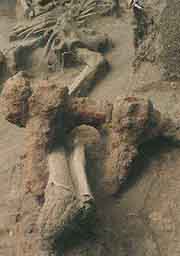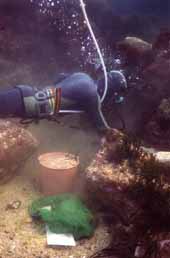|
The San Pedro de Alcantara summer campaign started in June with the coming to Portugal of Peruvian anthropologist Judith Vivar Anaya.
The results of the investigation of both the anthropologist and the archaeologist provided by the later during the 3rd Congress of Peninsular Archaeology held in late September 1999 in Vila Real de Tras-os-Montes, in northern Portugal and will be available in the 8th volume of the coming proceedings of this congress. Regarding the summer underwater campaign, decisive new results have been achieved through the excavation of a 400 sq.m. area of the sea-bottom. The area investigated was materialized in real-time at a scale of 1/20 in a seventy kilos clay model by Anita, a sculptor and long-time diver.
Head of the Conservation department at the Western Australia Maritime Museum, Fremantle, and world-known expert of corrosion processes on shipwreck sites, I. MacLeod generously brought an wholly new light and an essential understanding to the observation of the site and the processing of the data, focusing on a detailed observation of corrosion processes within the whole underwater scatter area and the general population of metallic artefacts. The ocean was part of the full supporters of this bright, long, shiny, busy summer, with no swell around, little wind and clear water for days in a row, an unusual feature for a coast widely opened to fog, northern winds and waves in that period of the year, a result of the stability of the Azores anticyclone and the associated cooling of the Portuguese waters lying to the East of the N. Atlantic high-pressure area. Something different occurred this time, with S. winds blowing one day after another, Neptune’s blessing as far as we were concerned. “You won’t get that again for the next fifty years” said an old shipbuilder living in the fishing town nearby, at the very end of August . But we got it and thank all those who helped to make this rare summer come true : among those are our friends, divers and participants who busily made the campaign come true, sometimes until physical exhaustion, weeks in a row ; the Portuguese Institute of Archaeology and its underwater branch (CNANS), the Peniche Municipality and several private companies including the Portuguese distributor of MapInfo software (spatially referenced data-processing tool), Telecel (wireless comm.), Entreposto (4-wheel drive 2,5 l. turbo Diesel pick-up by Nissan) and those at Grupo Forum (Lisbon) who believed in our faith and helped this episode of our search. Obrigado mar. Jean-Yves Blot, October 1999 Related texts
|


 Back to Nordic Underwater Archaeology
Back to Nordic Underwater Archaeology